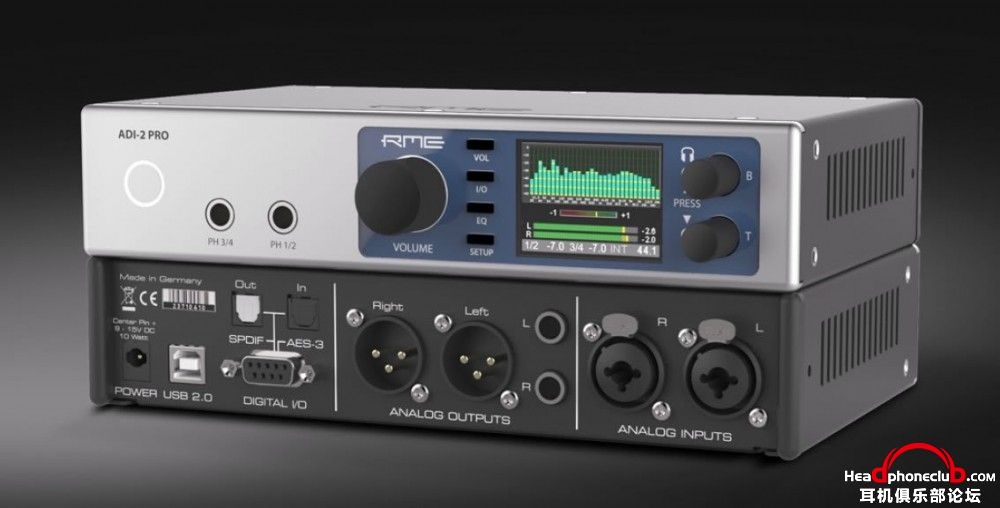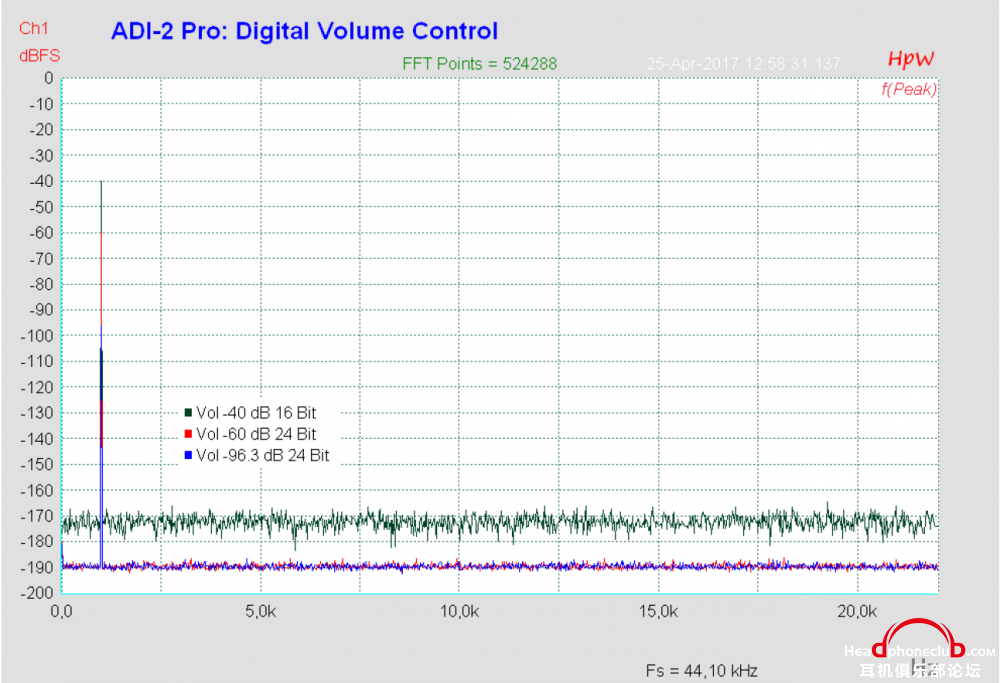|
|
感谢关注耳机俱乐部网站,注册后有更多权限。
您需要 登录 才可以下载或查看,没有账号?注册

x

RME ADI-2Pro貌似用户还很少,也没见过评价其音量的素质,昨天偶尔在其官方文档看到42bit数字音量的介绍,并附有测试图,一个CD 16bit/44.1的数字信号,数字衰减-40db后THD仍有-130db,可以说在数字处理部分是可以完全平移CD信号的动态了,如果DAC输出的模拟底噪(这台 ADI-2 pro按官方Signal to Noise ratio (SNR) @ +4 dBu: 115 dB RMS unweighted来换算,noise是-111dBu(2.18uV))与外部模拟前级的模拟底噪一致时,那是否可以与模拟前级PK一下了?
下面是摘自官方说明文档原文:
http://www.rme-audio.de/download/adi2pro_e.pdf (87-88页)
Digital Volume Control
The ADI-2 Pro deliberately avoids an analog level adjustment by means of a potentiometer. Its
digital version surpasses an analog one in practically every conceivable point. Typical
disadvantages of setting with potentiometers:
• Synchronicity errors lead to panoramic shifts and significant volume deviations left / right, in
particular near the end points of the adjustment range.
• In the middle setting range, there is an increased crosstalk and changes in the frequency
response. Changes in the frequency response also occur at the end regions of the
adjustment path.
• The setting range for optimum volume adjustment is often too small, or at the lower or
upper end of the potentiometer's adjustment range.
• Non-reproducible settings (except 0 and 11).
• Higher THD/THD+N. A point well known to measurement technicians. As soon as an
analog potentiometer is in the signal path, the unstable contact between wiper and resistive
track causes noise, which contains both THD (noise) and N (noise), even in the stationary
state. Thus the -110 dB of a DAC quickly get reduced to -80 to -70 dB.
Special volume ICs, which activate different resistance values by means of numerous electronic
switches, avoid some of the above mentioned points. Unfortunately, even the best of these ICs
do not achieve either THD or dynamics of the DACs used in the ADI-2 Pro, thus would affect its
analog output signal.
However, none of this is an issue with RME's digital volume control!
In fact an analog volume control has a (theoretical) advantage in only one point, namely the
maximum signal to noise ratio at a higher level reduction. In reality, current circuitry overturns
the theory, and the SNR at the output of such a device is no better than that of a digitally controlled
one. This is even more true the better the DA converter works and the less noise it has -
just like the ADI-2 Pro, which provides the maximum noise ratio over a wide level range of 20
dB, thanks to its four reference levels realized in the analog domain.
The most often cited issue of a digital volume control is an alleged loss of resolution at higher
attenuation. An example: 117 dB dynamic roughly equals 19 bit resolution. A volume attenuation
of 48 dB (8 bit) leaves 11 bit of resolution. Such a simple, but important details omitting
argumentation, usually ends with: the music must sound distorted in quieter parts, and the signal
to noise ratio is down to a useless 69 dB.
The former is simply wrong, the latter irrelevant in practice. Indeed there is a reduced signal to
noise ratio, but it doesn't matter, as the noise was not audible before (below the hearing threshold),
and is still not audible after lowering the level. And the reduced SNR also applies to
devices with potentiometers, since the potentiometer is never placed at the output, but in the
middle of the circuit, followed by further electronics which also add some basic noise.
The quality of the ADI-2 Pro's digital volume control is best shown by measurements. Hard
times coming up for convinced supporters of the analog control, because here it is very clear
that the disadvantages of a digital volume adjustment, such as roughness and distortions at
higher attenuation, simply do not exist - at least with RME.
The following measurement shows a digital full-scale sine of 1 kHz, 16 bits without dither, which
is reduced in level by 40 dB. Also shown are a full-scale sine of 1 kHz with 24 bit, at 60 dB and
96.3 dB level attenuation, which is the lowest volume setting the ADI-2 Pro offers.
A high-resolution FFT like HpW Works makes it possible to disassemble the signal into
individual frequencies, and to identify unwanted components down to a level of -190 dBFS. The
measurement shows that the undithered 16 bit signal does not produce any distortion or other
tones above -170 dBFS. So at a volume setting of -40 dB the measurable THD is -130 dB. At 24
bit a volume setting of -60 dB also achieves -130 dB without distortion. And at a volume setting
of -96.3 dB there are still -93 dB THD measurable.

These results clearly show that distortion products of the digital volume control are not drowned
by the DAC's noise, but are not generated at all. It works perfectly even with an undithered 16
bit signal, no detectable distortion products are produced.
If the volume control is measured at the analog output, the demonstrable THD is reduced to
around -100 dB at a volume setting of -60 dB, by the self-noise of the DAC (SNR 117 dB RMS
unweighted). In the above measurement that would be seen as straight noise floor at -160
dBFS. The digital volume control of the ADI-2 Pro therefore works much more precisely and
cleaner than required for current top-level DACs.
In summary:
RME's digital volume control in 42 bit TotalMix technology avoids all the disadvantages of
analog level control via pots, is easy to use, offers reproducible settings, and the highest sound
quality.
以下是官网参数:
Analog Inputs
XLR
• Input: XLR, servo-balanced
• Input impedance balanced: 18 kOhm, unbalanced: 9 kOhm
• Input sensitivity switchable +24 dBu, +19 dBu, +13 dBu, +4 dBu @ 0 dBFS
• Digital Trim Gain range: 0 dB up to +6 dB
• Signal to Noise ratio (SNR) @ +13/19/24 dBu: 120.x dB RMS unweighted, 124.x dBA
• Signal to Noise ratio (SNR) @ +4 dBu: 119 dB RMS unweighted, 123 dBA
• Frequency response @ 44.1 kHz, -0.1 dB: 5 Hz – 20.5 kHz
• Frequency response @ 96 kHz, -0.5 dB: 3 Hz – 45.5 kHz
• Frequency response @ 192 kHz, -1 dB: 2 Hz – 92.7 kHz
• Frequency response @ 384 kHz, -1 dB: < 1 Hz – 124 kHz
• Frequency response @ 768 kHz, -3 dB: < 1 Hz – 180 kHz
• THD @ -1 dBFS: -116 dB, 0.00016 %
• THD+N @ -1 dBFS: -112 dB, 0.00025 %
• Channel separation: > 110 dB
Analog Outputs
1/2 XLR
• Output level switchable +24 dBu, +19 dBu, +13 dBu, +4 dBu @ 0 dBFS
• Signal to Noise ratio (SNR) @ +13/19/24 dBu: 117 dB RMS unweighted, 120 dBA
• Signal to Noise ratio (SNR) @ +4 dBu: 115 dB RMS unweighted, 118 dBA
• Frequency response @ 44.1 kHz, -0.1 dB: 0 Hz – 20.2 kHz
• Frequency response @ 96 kHz, -0.5 dB: 0 Hz – 44.9 kHz
• Frequency response @ 192 kHz, -1 dB: 0 Hz – 88 kHz
• Frequency response @ 192 kHz, -1 dB: 0 Hz – 88 kHz
• Frequency response @ 384 kHz, -1 dB: 0 Hz – 115 kHz
• Frequency response @ 768 kHz, -3 dB: 0 Hz – 109 kHz
• THD @ -1 dBFS: -112 dB, 0.00025 %
• THD+N @ -1 dBFS: -110 dB, 0.00032 %
• THD @ -3 dBFS: -116 dB, 0.00016 %
• Channel separation: > 110 dB
• Output impedance: 200 Ohm balanced, 100 Ohm unbalanced
|
|
 |联系我们|有害信息举报:010-60152166 邮箱:zx@jd-bbs.com|手机版|Archiver|黑名单|中国耳机爱好者俱乐部
( 京ICP备09075138号 )
|联系我们|有害信息举报:010-60152166 邮箱:zx@jd-bbs.com|手机版|Archiver|黑名单|中国耳机爱好者俱乐部
( 京ICP备09075138号 )